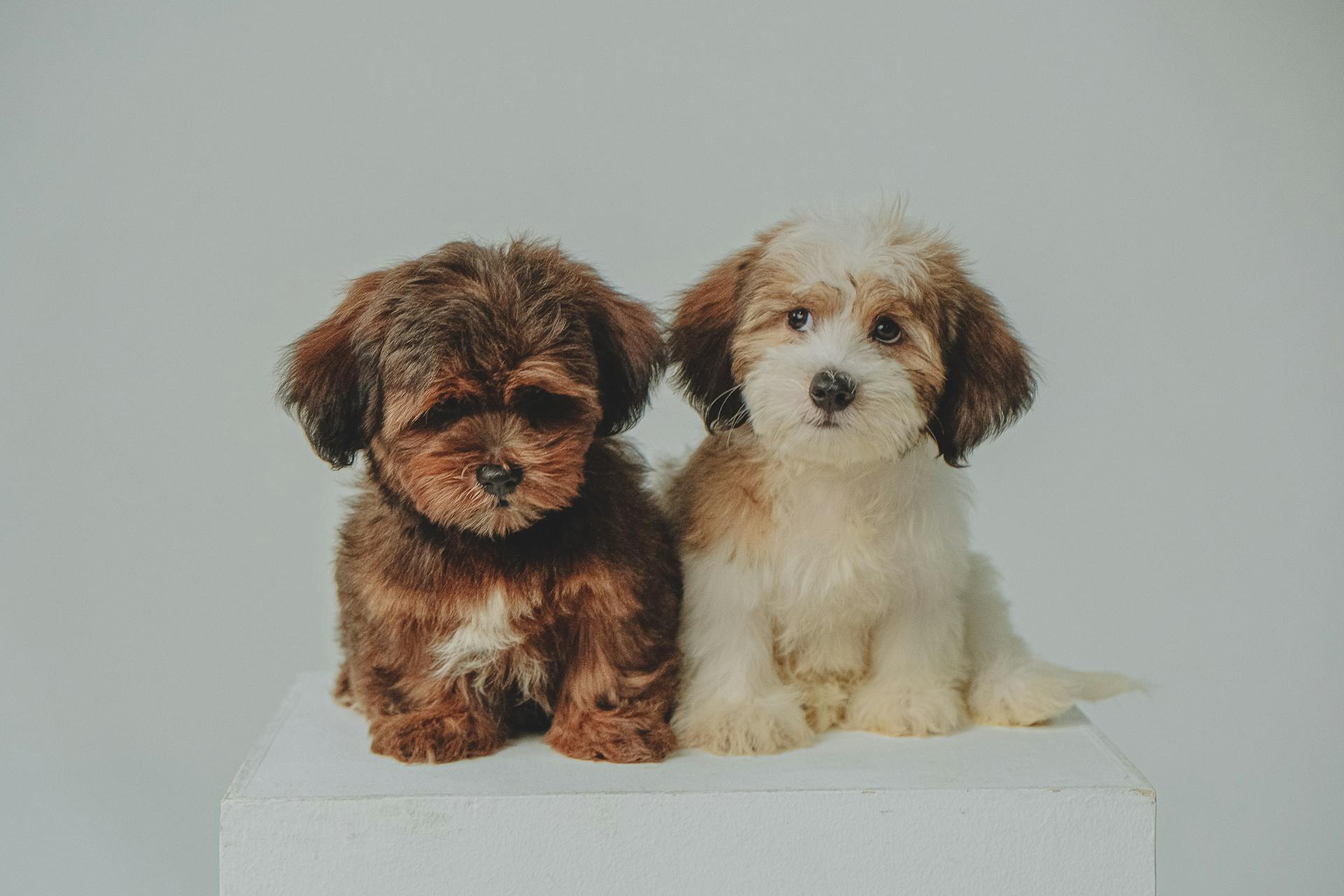
If your furry friend is scratching like crazy due to flea allergies, don't worry - there are some amazing home remedies that can bring them relief.
Oatmeal baths are a great way to soothe your dog's itchy skin, as they contain anti-inflammatory properties that can help reduce redness and irritation.
Try using a humidifier in your home to reduce dry air, which can exacerbate flea allergy symptoms in dogs.
Apple cider vinegar can be added to your dog's bath water to help balance their skin's pH and reduce itching.
Aloe vera gel can be applied directly to your dog's skin to calm and soothe irritated areas.
Some dog owners swear by using a mixture of equal parts water and white vinegar as a spray to help repel fleas and reduce itching.
Remember to always consult with your veterinarian before trying any new remedies, especially if your dog has a severe flea allergy or is taking medication.
On a similar theme: Can Dogs Get Allergies
Causes and Symptoms
Dogs with flea allergies can experience a range of symptoms, but it's essential to understand the possible causes behind these issues.
Flea allergy dermatitis is a common cause of skin problems in dogs, leading to extreme itchiness and often resulting in skin infections.
It's not just fleas that can cause skin issues – allergies, contact irritation, skin parasites, and medical conditions like hormonal imbalances or autoimmune diseases can also be to blame.
Dog rashes can appear anywhere on the body, but they're often found on the belly, groin area, underarms, and paws.
Some common symptoms of dog rashes include redness of the skin, itchiness, excessive hair loss, and flaky skin.
Here are some possible causes of dog rashes:
- Fleas and flea allergy dermatitis
- Allergies (environmental, seasonal, food, or contact)
- Contact irritation (shampoo, cleaning products, collars, etc.)
- Skin parasites (mites, ticks, lice)
- Medical conditions (hormonal imbalances, autoimmune diseases)
- Obsessive chewing or licking behavior due to stress or boredom
- Bacterial or fungal infections
It's worth noting that some dogs may experience additional symptoms, such as digestive upset or increased urination, depending on the underlying cause of their skin problems.
Prevention and Treatment
Preventing flea allergies in your furry friend is key to avoiding the discomfort and stress they can cause. Regular use of a good quality flea prevention year round can make a big difference.
To keep your dog's skin and coat healthy, feed a nutritionally complete and balanced dog food, and maintain their skin and coat with regular baths or professional groomings. The frequency of baths or haircuts varies depending on breed and lifestyle.
Some herbal options like eucalyptus, rosemary, fennel, and yellow dock can be used as a natural remedy to discourage fleas from biting. However, always check with your vet before administering any new remedy.
If your dog does develop a flea allergy, antihistamines like Benadryl can be used to relieve the itch and inflammation. Steroidal medications like prednisone and cortisone can also be effective in treating the symptoms.
In addition to medication, there are several home remedies that can help soothe your dog's skin and alleviate the discomfort of flea allergies. These include soothing shampoos, antiseptic solutions, and hydrocortisone cream.
Here are some home remedies you can try:
- Soothing shampoos (aloe or oatmeal based)
- Hydrocortisone cream (apply directly on the rash, but be sure your dog doesn't lick and ingest it)
- Gentle antiseptic solutions (such as dilute chlorhexidine) for cleaning shallow wounds or infected skin
Remember to always check with your vet before giving any new medication or supplement, and to follow their advice on the best course of treatment for your dog.
Identifying and Managing
Identifying flea allergies in your dog can be a challenge, but look for symptoms like intense itching, redness, and skin irritation, especially around the ears, neck, and tail.
Fleas can cause a range of issues, from mild discomfort to severe skin problems, so it's essential to address the problem promptly.
To manage flea allergies, regular grooming is a must, as it helps to relieve symptoms and prevent further irritation.
Brush your pet daily using a flea comb to remove fleas and their eggs, and bathe your pet every one to two weeks to wash away and kill fleas.
Here are some common treatments for flea allergies that you can try at home:
- Medicated shampoos, creams, ointments, or sprays
- Antihistamines such as Benadryl to prevent allergic reactions
- Ear cleanings and ear medications to address ear infections
- Wound care to clean and treat any moist or oozing wounds
Remember to consult with your veterinarian before starting any new treatments, especially if your dog's symptoms persist or worsen.
Herbal Dermatitis Treatment
If you're looking for a natural remedy for flea allergy dermatitis, consider trying eucalyptus, rosemary, fennel, and yellow dock. These herbs can be mixed together in equal parts and sprinkled on your pet's coat several times a week to discourage fleas from biting.

Before using any herbal remedy, it's essential to check with your vet to ensure the particular herb is safe for your pet's breed and specific situation. Your vet can also provide specific dosages for your animal's size.
Some herbal combinations to consider include:
Remember, herbal remedies may not be as effective as conventional treatments, so it's crucial to work with your vet to determine the best course of treatment for your pet.
Spot the Signs
Flea allergy dermatitis (FAD) can be a real challenge to spot, but there are some telltale signs to look out for.
Your pet may itch for up to 2 weeks after a bite, and the itching will be severe and even damaging to their skin.
A rash on your pet's skin or raw, irritated, or bleeding areas on their body are common symptoms of FAD.
Dogs usually have it near their back legs, stomach, or tail area, while cats are more likely to have it near their neck and face.
Expand your knowledge: Pet Health Dog Tear Stain Remover

Hair loss, especially in areas where the bites happened, is another sign of FAD.
Small red or pink raised bumps that may look like pimples can also be a symptom of FAD.
Constant itching, biting, clawing, or grooming can be a sign that your pet is suffering from FAD.
Here are some common symptoms of FAD:
- Rash on your pet's skin
- Raw, irritated, or bleeding areas on your pet's body
- Hair loss in areas where bites happened
- Small red or pink raised bumps
- Constant itching, biting, clawing, or grooming
Brush Your Pet
Brushing your pet regularly can make a huge difference in managing flea allergy dermatitis. Using a flea comb to brush your pet daily removes fleas and their eggs.
Brushing your pet daily will help get rid of fleas and their eggs. Bathing your pet every one to two weeks also helps wash away and kill fleas.
Suggestion: Flea Eggs in Dog Fur
Allergies
Allergies are a common cause of flea allergy dermatitis in dogs, and understanding the different types of allergies can help you provide the best care for your furry friend. Allergies can be seasonal or environmental, and they can also be caused by food or contact with certain substances.
Atopy, or environmental allergies, is the most common type of allergy in dogs and can cause symptoms such as itching, scratching, and skin rashes. Flea allergy dermatitis, on the other hand, is an allergic reaction to flea bites that can cause intense itching and skin problems.
Here are some common symptoms of allergies in dogs:
- Redness of the skin
- Itchiness (chewing or scratching at the skin or ears)
- Excessive hair loss, dull fur, or bald patches
- Flaky skin, dander, or oily skin
- Bumps, pustules (pus-filled bumps), scabs, crusts, or wounds of the skin
If you suspect that your dog has allergies, it's essential to consult with a veterinarian to determine the underlying cause and develop a treatment plan. Your vet may recommend antihistamines such as Benadryl, skin supplements, or a special diet to help manage your dog's allergies.
Featured Images: pexels.com


